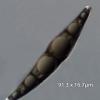
09-01-2026 17:41
Arnold BüschlenHallo, F. dilatata wird von vielen Bryoparasiten

09-01-2026 10:08
 Blasco Rafael
Blasco Rafael
Hola, en el mismo habitat que la anteriorRetamaDia

08-01-2026 21:22
 Blasco Rafael
Blasco Rafael
Hola, He recogido esta muestra de Orbilia sobre Re

07-01-2026 10:24
 Danny Newman
Danny Newman
Pezicula sp. on indet. hardwood Appalachian Highl

07-01-2026 22:22
 Danny Newman
Danny Newman
Tatraea sp. on indet. hardwood The Swag, Great Sm

07-01-2026 17:29
 Marc Detollenaere
Marc Detollenaere
Dear Forum,On a barkless Populus I found some smal

10-11-2021 17:33
 Riet van Oosten
Riet van Oosten
Add-on topic http://www.ascofrance.com/forum/7059

07-01-2026 10:05
 Danny Newman
Danny Newman
cf. Chaetospermum on XylariaCosby Campground, Grea

02-01-2026 17:43
MARICEL PATINOHi there, although I couldn't see the fruitbody, I
 Bonsoir tous
Bonsoir tousthe 'foam-cakes' which can develop in fast flowing streams are a very interesting habitat for the so-called 'Ingoldian Fungi'.
Examples of some of the often distinctive conidia found can be seen here:
http://www.ascofrance.com/search_recolte/3964
http://www.ascofrance.com/search_recolte/3943
http://www.ascofrance.com/search_recolte/3010
Amongst these "aquatic hyphomycetes" one often sees diatoms and other algae, lepidopteran wing scales, pollen etc.; and also chance fungal spores from unknown fungi (which may or may not be aquatic in origin). Normally one ignores these, but occasionally one finds something so striking there may be a hope of getting an identification, even from a single spore. Here is an example of this and I am hoping that such a distinctive spore (which is surely an ascospore - Pleosporales or similar?) will be recognised by someone here. Notable are the large size of the spore and the very distinctive hyaline tips at each end (which are not formed within a single cell - the terminal cells are part-coloured). It may not be evident from the photograph, but the spore is 8-septate.
As ever any suggestions would be very welcome.
Chris
could be an ascospore of Trematosphaeria hydrela.
Best wishes,
Gernot
Exactly !
It's more common to find conidias of the anamorphic stages, ingoldian fungi, but sometimes there are ascospores of the sexual stage. One can also find non-aquatical spores.
Alain

Hi Chris and Gernot,
I fully agree with Gernot: this should be the spore of Trematosphaeria hydrela! I quite often found these species on deciduous wood in rivulets.
Regards from Lothar

